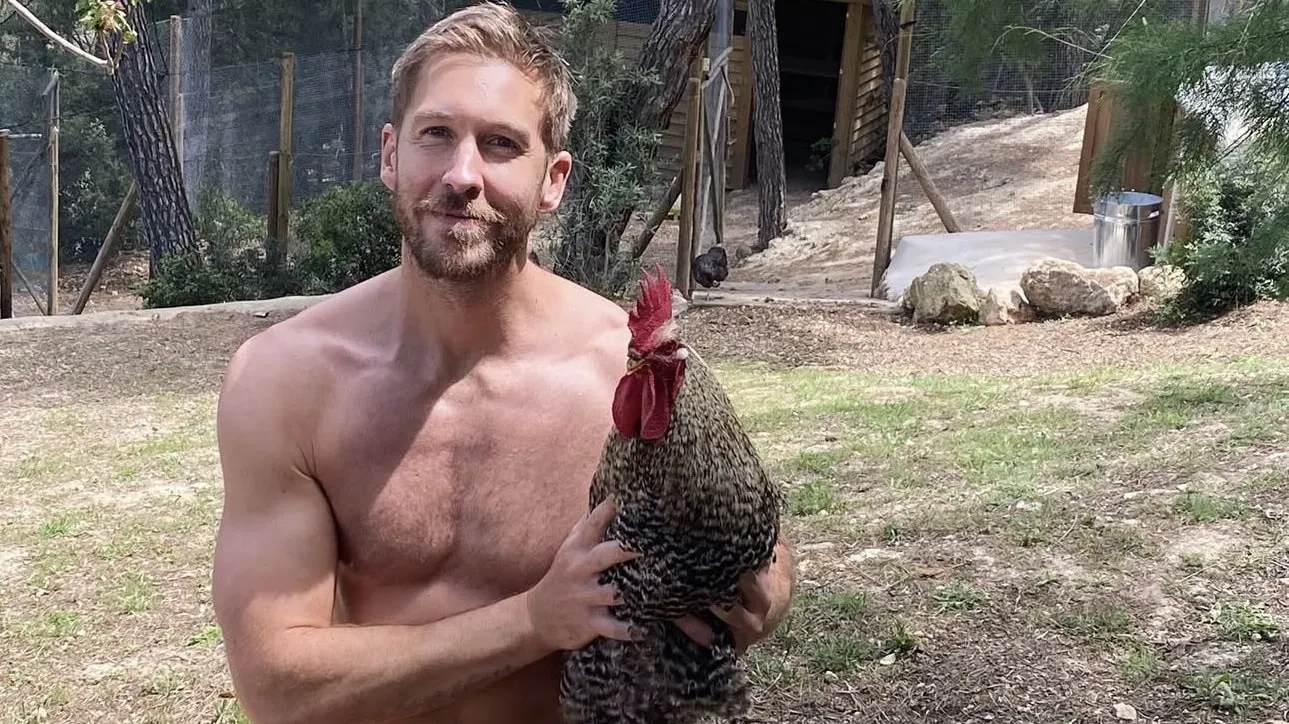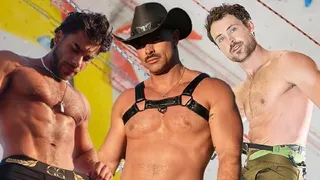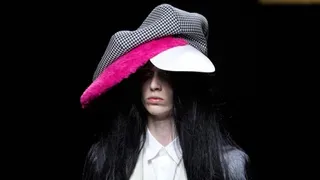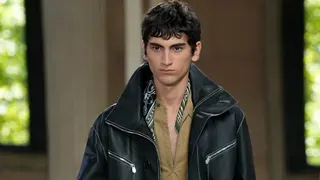July 8, 2020
Out Singer-Songwriter Rachel Garlin on Her 'Mondegreens'
Kilian Melloy READ TIME: 14 MIN.
If you've been feeling stuck in place (physically, sheltering from COVID-19, or emotionally, punch-drunk and numb from the relentless hammering our country has taken (politically, socially, and economically) of late, then Rachel Garlin's latest album, "Mondegreens" (released April 3) might serve as a healing soundtrack or a sonic comforter, the equivalent of a warm blanket together with a cup of cocoa.
But the solaces "Mondegreens" offers are not sedentary: The song "Out There" – a track originally composed for a VR immersive musical – casts the terror of the outside world against the safety of our personal cages. The song acknowledges the dangers, but also celebrates the possibilities, of venturing out to see what awaits us.
Garlin presents nine new songs on her new album, as well as putting her own spin on a classic. The tracks are pure Garlin: Clean melodic lines, expressive musicianship, and the occasional country-esque guitar twanging or plucking away, along with violins lending a hint of bluegrass, in the background. Faceted gems of lyrical storytelling blend music and words to create startling, rich narratives. As with Garlin's earlier albums, the more you listen to these songs the more you fall in love with them.
"Cheers to You," for instance, draws uneasy and yet hopeful parallels between the narrator, who seems to be contemplating downing a bottle of pills, and a woman who's being addressed – "All knuckles and nerves / You grow angry fast / With your fists in curls" – who has seemingly wrestled with the sorts of issues many in the LGBTQ community have, since she's been "swallowing stigma and fears / On the rocks for years."
"Radio Silence" is a gentler song, but no less complex and deep; its music box instrumentation creates a glittery fairytale setting for Garlin's soothing, sleepy time lyrics. Spangled with planets and stars and a "muted moon" like a child's playfully decorated bedroom, the track's "radio silence / Sings like a lullaby."
The album's title track takes its name from a word that refers to misheard song lyrics – and who knew there was a word for that? – but the story it tells is that of adoration for, and fascination with, a romantic interest so captivating that even her fingers and toes provide endless distraction. There may be a gap between who we see before us and who that person actually is, but – as Garlin happily, hopefully proposes – "...you may not know the difference / And sing the wrong words for your whole life / Maybe the wrong words, the wrong turns / The long way leads to the light."
From the Valentine to her San Francisco neighborhood that is "Earthquake Town" to the tale of delirious freedom after leaving a troubled relationship in "Good Morning," Garlin paints in vivid emotional colors. But perhaps the biggest surprise is her leisurely, introspective acoustic read on Don Henley's hit "The Boys of Summer" – an epic hetero love song that's been recast, Garlin tells EDGE, with a glance beyond that familiar "male gaze."
With her video for "The Boys of Summer" about to drop – and summer in full swing – this was the perfect moment to catch up with Garlin for a chat about the album and to learn more about her creative process.
EDGE: How are you holding up in this crazy, crazy time?
Rachel Garlin: Oh, my goodness – moment by moment, day by day, song by song. It's hard to capture.
EDGE: Are you actually addressing all this, or processing it for yourself, with your songwriting?
Rachel Garlin: I think I must be. I'm on a weekly songwriting group now on Zoom, and we've all committed to writing a new song every week. It's been intense, hearing these eight to twelve songwriters each week. The attunement with the news cycle is really apparent.
EDGE: Are there one or two themes people in your group are talking about or are they writing about everything across the board – inequality, police brutality, COVID-19, the economy, the election...
Rachel Garlin: It's all fair game. All those topics have been in people's lyrics and in our discussions. The songwriters are very writing "what's in the room." But, you know, there will still be love song and songs about all kinds of different relationships. You just deal with it when you're hearing a batch of very current songs.
EDGE: Let's talk about your new album, "Mondegreens." One of the songs on the album, "Out There," was written for a musical (the first VR immersive musical!) about a little girl who has to stay indoors, but the whole album seems like a perfect musical companion for isolating at home and socially distancing. Was isolation or disconnection a larger theme you were writing about for this album?
Rachel Garlin: There's increasing pressure in our society to disconnect, stay separated and put up walls. The emphasis leaves people feeling isolated, pushed to the sides or much worse. Writing songs based on conversations with real people certainly makes me feel more connected to the common threads between us.
I wrote the song "Out There" from the perspective of a girl who's forced into physical isolation while being bombarded with negative messages about why she needs to stay inside, stay apart, stay isolated. But there are other voices reaching her too, about the enduring strength of the human spirit and how the world is complicated and dangerous but also inviting and available for exploration. When we're isolated, it's hard to hear all of the voices that we need to hear about stepping out, being out, and just feeling the freedom to live.
EDGE: So your creative process is rooted in a social experience.
Rachel Garlin: Definitely. That's an important part for me in writing songs. I've always been motivated by human connection... it's part of what I love about being a singer-songwriter. For me, the songwriting process often starts with a "social experience," as you said, and that experience can be a conversation with someone I know, or a chance interaction with a stranger on the train.
Pre-COVID, I had a practice of riding the San Francisco MUNI train once a week and bringing an instrument with me and purposefully engaging with fellow travelers. These exchanges with people and then any observations on personal dynamics and stories in the news... all of these are the stuff of songwriting.
EDGE: Speaking of "Out There" and the immersive musical it was written for – what an interesting project! How did you come to work on it?
Rachel Garlin: The producers at Pollen Music Group reached out to me about writing a song on spec for a new musical in augmented reality (AR). Pollen was working in collaboration with Wilkins Avenue, French a VR firm specializing in immersive experiences, to create the world's first immersive musical in augmented reality. They provided a story brief about the protagonist, Liv, who is trapped in her room and hearing voices from foreboding ancestors and an encouraging, yet absent, mother. I came up with "Out There," and they produced a beautiful soundtrack featuring the voice of Grammy-nominee Vanessa Williams as "the mother." The AR musical had its world premiere in Paris last October (2019) and it was a thrill to be on set at the opening and see the project come to life.
EDGE: I have always loved the way your songs tell short stories, as opposed to offering a snapshot or musing on a simple emotional response. Do you see yourself as being a short story writer of sorts when it comes to your lyrics?
Rachel Garlin: In some sense, yeah. I definitely like to paint a picture and to develop characters – not super-intentionally. I think of short story writers as people who are really good at planning, and mapping out the plot and the story arc and those are not my strengths. I don't think I could write a short story without the musical piece.
Certainly, part of what is challenging and satisfying about writing a song is trying to narrate something that is true, and to animate characters that are real for me. There's always some "real life story" behind the songs, even if it's based on something in literature or a conversation I've overheard rather than something I've directly observed. But direct observation is how I write most of my songs. I write what's in the room (or on the train) and go from there.
There are a lot of stories in the songs, and it's nice when people resonate with them or find them because sometimes they are a little bit under the surface. Other times, they're right out there; it just depends.
EDGE: I admire how your lyrics are constructed; they are so well fit to the music, and so neatly put together. Do they come to you pretty naturally or do you have to slave over every word?
Rachel Garlin: Well, thank you for saying that! I do a lot of improvisation when I am writing songs, and sometimes I find that the combination of unself-conscious riffing and then editing, or going back and emphasizing certain themes by choosing different words can be an effective path for me to finish songs.
I'm interested in the idea of having a "beginner's mind" and approaching the work as if it's the first time I've ever written a song. That way, I can silence the inner critic who's saying "You can't write another song with those chords" or "this song is dumb" or whatever other barbs I try to throw at myself. I just try to keep the process moving forward until I have a complete first draft. I'm a fan of Ann Lamott's idea to write a "shitty first draft"... so that you get an idea out quickly before going into editing mode.
I usually start by playing chords on the guitar or (sometimes) piano while improvising melodies and lyrics. I might do this while sitting on the front stoop and watching the neighborhood go by, or I might do it tucked into my salvaged old fashioned photo booth where I can find quiet in a busy house.
[The songwriting process] kind of has the have both: The spontaneous start, with the [sense of], "Hey, I'm just writing this for fun and it's not gonna be a finished product," and therefore the inner critic can go away, combined with the feeling that, yeah, there is precision in art, and it's important for me to go back and edit – which does involve thoughtfully choosing words or finding lyrics that want to go with the music. I'm definitely into the idea that the lyrics and the melody are mates. They're married. That's why I write lyrics and melodies at the same time.
EDGE: I understand you have color synaesthesia. When you say you are painting a picture with your songwriting, do you mean that literally?
Rachel Garlin: I think somewhat; it's not conscious, but I do see things in color, like days and numbers and names. I think it means that I engage with, and mix, different sensory inputs when I'm writing. For example, if I'm starting a song and I'm improvising lyrics about riding the train on a Thursday, I'll be singing in the color of a Thursday, which for me is this sort of soft green color – the color of a lamb's ear plant. So, somehow Thursday is this color indelibly in my mind, and therefore that's the color that I'm painting with. But it's not like I map these things out; again, I'm not a planner. I don't map songs out or have a color theme. I just go with the mood that attaches to a song.
Maybe there's a color palette for each song, and maybe I (subconsciously) stay within the palette for that song. It affects the words I choose and yes, the melodies too. But I'm still learning about it, so I'm not entirely sure.
EDGE: But you would certainly know if a color didn't fit, if it clashes.
Rachel Garlin: Definitely!
[Laughter]
Rachel Garlin: And that's true when I'm doing my album art, too. The graphics and lyrics [have to go together], and it can be really jarring if a color doesn't fit.
EDGE: Let's talk about a few of the specific tracks from the album. "Mondegreens," the title song, is the term for when a person mishears song lyrics and ends up substituting words of their own invention in place of the actual words. What prompted you to write a song about this?
Rachel Garlin: It was because I was in a songwriting workshop with three songwriters that I greatly admire, and they were in a conversation about this idea of mondegreens, and I had never heard of this word. I needed a definition of the word, and when I found out what it was, I was intrigued with this idea and thought about it in terms of interpretation.
The song, and album title, "Mondegreens" came from a place of acknowledging the role that mistakes (i.e. "the wrong words, the wrong words") play in our overall life journeys. When we sing along with songs we know and sing the "wrong" lyrics, we're actually singing the "right" lyrics. There is no wrong and right when it comes to how we interpret art, music and life. And if we mistakenly assign meaning that's different from how a lyric was intended, then we've created our own meaning.
I like the idea that songs have their own lives, separate from the songwriter, and that listeners will make their own meaning based on what they hear. We're all influenced by the music we heard growing up; we interpreted it in our own ways. For me, as a young person who was gay and wasn't out, I was really intrigued with the lyrics of artists who were out. So I would pour over their lyrics, like the Indigo Girls, and I'm sure there were a lot of mondegreens in there for me, because I didn't always have a copy of the record – I was listening on the radio. I made all kinds of meanings out of their songs, and all kinds of other songs that were about relationships that I could relate to or that I was gonna have, but that I could sort of interpret my own way by sort of subconsciously mishearing things. I thought it was a metaphor for how we make meaning, and we make new meaning from the art that we love.
EDGE: It does seem to be an impulse for people to try to find themselves in art.
Rachel Garlin: Yeah. I think so. I mean, as a songwriter I love to paint pictures of other people's stories. People might assume that a song is autobiographical, but it's often not. That's another form of interpretation – people might interpret a song as being about my real life, or about their real life, but it's actually about this third person's real life. You can't control how people are going to hear your words, and that's a great thing. It's a moment when we can let go of over-controlling everything, which I think there can be a tendency to do in our culture.
EDGE: Do you have any memorable mondegreens that you wouldn't mind sharing?
Rachel Garlin: One of my mondegreens from childhood happens in Bonnie Tyler's "Turn Around Bright Eyes." At the high point of the song she exclaims "Living in a polygag and giving up starts!" In my head, a polygag (not a real word as far as I know), was a confusing relationship that never got past the start. When I learned the real lyrics I was also confused, because "Living in a powder keg and giving off sparks" was equally inscrutable to me... As I kid I didn't know what either a polygag or a powder keg was, so I just stuck with my mondegreen and it was all good!
So yes, it's about making your own meaning. I like the idea that the term was coined by someone (Sylvia Wright) who spent her life thinking that there was a person named Lady Mondegreen, but actually the lyric was "laid him on the green."
EDGE: The line "You can't stick a stake in shaky ground" is a great image derived from you living in San Francisco. I also love the line that describes a "row of palm trees dripping with poems and tears." Does San Francisco, or your environment in general, serve as a conduit for inspiration?
Rachel Garlin: Yeah in that track, "Earthquake Town," I was inspired by the history of Dolores Park, which is a big park just down the street from where I live. The park has been kind of a contested ground ever since the very beginning. I was interested in that history of our city, and also how there's so much contested ground right now. It's a complicated place – lots of struggles and contradictions are going on right now. Dolores Park has been everything from a wilderness to a cemetery to a shantytown to a park, and now even as a park it has different communities who stake a claim to it. I thought that was a good representation of this particular vibrant city. I wrote it before COVID, but the optics of the city are different under lockdown. You see different negative spaces, different vacancies and voids – and then, different places that remain crowded. It's a chance to see the city through a different set of experiences that we're all having together.
EDGE: One surprise here was your cover of Don Henley's "The Boys of Summer." To be honest I almost didn't want to hear it because I always fear covers of favorite songs, but you did that rare and wonderful thing and gave the song a reading that seems fresh and unique, something of its own without taking anything away from the original. Why did you choose this song to cover?
Rachel Garlin: My friend Kate Isenberg, who is a longtime collaborator, was shopping at Trader Joe's and the song came on, and she just had the idea that it would be fun to cover. She called me from the store and said, "We should cover it for your next show." I brought it to my producer, Julie Wolf, and she wrote the harmony arrangement. Kate wrote the mandolin part and we had our version!
On our recording, I don't sing the melody... Kate does... I sing the harmony on the choruses. So, in addition to being a bit of a gender-bender, we also had fun creating our own interpretation of the arrangement.
EDGE: "The Boys of Summer" just seems like a song that is sung about a woman. (Although, hmmm, all sorts of interesting possibilities crop up if you think about it being written for a man!) Have you heard anything from Don Henley about his song now telling the story of a relationship between two women?
Rachel Garlin: No word from Don, yet. But I'll keep my text notifications ON! That's a good point though... we should send it to him!
[Laughter]
Rachel Garlin: It's a well-known Don Henley song about guys competing for the attention of a woman. Maybe our version (three female voices) opens up space for something more than the typical boy-meets-girl summer love story... it's a riff on the original "male gaze" perspective of the song. We had fun with it and decided to record it for the album. My producer Julie Wolf has many super powers, but one of them is knowing how to reimagine and re-interpret songs. I love what she brought to "Boys of Summer" (and the whole album) with her arrangements and choice of musicians.
Our video for "The Boys of Summer" is going to premiere in "Guitar Girl Magazine." It's scheduled to premiere on July 7.
EDGE: Is it just me, or is "Good Morning" the most chipper breakup song ever?
Rachel Garlin: Ha! You are correct. But I think it goes into the bucket of no beginnings, no endings. Just mornings and evenings. I'm a morning person (although increasingly also a night-owl?) and so mornings almost always feel hopeful to me.
My friend told me the story of her thirty-year marriage, and I loved what she shared about their tradition of using silverware to spell birthday messages on the breakfast table. I heard wistfulness as well as the innocence of new mornings... the dance that relationships do... so maybe it's good mourning as well as good morning.
To learn more about Rachel Garlin, please go to https://rachelgarlin.com/
Kilian Melloy serves as EDGE Media Network's Associate Arts Editor and Staff Contributor. His professional memberships include the National Lesbian & Gay Journalists Association, the Boston Online Film Critics Association, The Gay and Lesbian Entertainment Critics Association, and the Boston Theater Critics Association's Elliot Norton Awards Committee.





